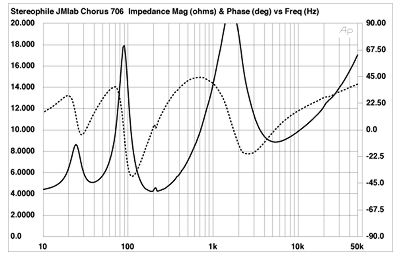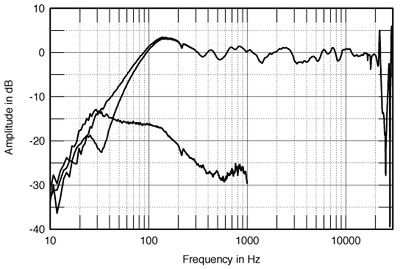| Columns Retired Columns & Blogs |
JMlab Chorus 706 loudspeaker Measurements
Sidebar 3: Measurements
The JMlab Chorus 706 is specified as having a highish 89.5dB sensitivity; my measured figure was somewhat lower, at around 87dB, which is average. The speaker's impedance (fig.1) drops below 6 ohms only briefly in the lower midrange and the midbass, and while the electrical phase angle does approach ±45 degrees, this never coincides with a low magnitude. As a result, the 706 will be relatively easy to drive.
The blip at 200Hz in both of the traces in fig.1 suggests the presence of some kind of cabinet resonance at that frequency. There is a strong mode at this frequency present on the side panels, though the waterfall plot calculated from the output of a simple accelerometer attached to the center of the top panel (fig.2) indicates that the strongest resonant mode present actually lies at 176Hz. However, the amplitude of these modes is not high, and it is possible that the only subjective consequence will be a thickening, or warming, of the speaker's lower mids.

Fig.1 JMlab Chorus 706, electrical impedance (solid) and phase (dashed). (2 ohms/vertical div.)

Fig.2 JMlab Chorus 706, cumulative spectral-decay plot of accelerometer output fastened to center of top panel. (MLS driving voltage to speaker, 7.55V; measurement bandwidth, 2kHz.)
The saddle at 40Hz in the impedance-magnitude trace suggests a fairly low tuning frequency for the front-mounted rectangular port, though the low height of the lower in frequency of the two impedance peaks in the bass suggests an overdamped alignment. The limited port output can be seen in fig.3; it peaks between 25Hz and 40Hz, but the port's close proximity to the woofer makes the upper-frequency response in this measurement somewhat suspect. Nevertheless, the port appears to provide only minimal extension of the speaker's output below 100Hz.

Fig.3 JMlab Chorus 706, anechoic response on tweeter axis at 50", averaged across 30 degrees horizontal window and corrected for microphone response, with the nearfield woofer and port responses plotted below 300Hz and 1kHz, respectively.
Note that there are small glitches just above 200Hz in both the woofer's and port's nearfield responses, which will be associated with the cabinet resonance discussed earlier. The on-axis trend throughout the midrange is basically flat, with what peaks there are balanced by similar-sized dips. The upper bass appears lifted in this graph, but this will be at least partially due to the assumption of an infinite boundary condition by the nearfield measurement technique. By itself it does not suggest a reason for BJR's finding the 706 to have a "warm, rich character in the lower midrange." And although BJR noted that the speaker's "lower high frequencies were somewhat sweetened," its on-axis response is flat throughout the treble.
The 706's lateral-radiation pattern plot (fig.4) suggests that BJR was reacting to, at least with respect to the high frequencies, the 706's very limited dispersion above 8kHz. This will indeed make it sound "sweetened" in all but very small, very live rooms. The very slight flare apparent at the bottom of the tweeter's passband in this graph would, all things considered, add a slightly bright character to the 706's in-room presentation. But this flare actually coincides with a lack of on-axis energy, which will tend to compensate for the off-axis excess.

Fig.4 JMlab Chorus 706, lateral response family on tweeter axis at 50", from back to front: differences in response 90 degrees-5 degrees off-axis, reference response, differences in response 5 degrees-90 degrees off-axis.
Fig.5 shows a similar plot for the JMlab's dispersion in the vertical plane. (In figs.4 and 5, only the differences between the off-axis plots and the on-axis response are shown, which is why the latter appears to be a straight line.) The Chorus 706 seems very fussy about exact listening axis, a big suckout developing in the crossover region more than 5 degrees above or below the tweeter axis. I suspect that these suckouts lead to a lack of in-room presence-region energy, which will accentuate the warm character resulting from the slightly elevated upper bass.

Fig.5 JMlab Chorus 706, vertical response family at 50", from back to front: differences in response 45 degrees-5 degrees above tweeter axis, reference response, differences in response 5 degrees-45 degrees below tweeter axis.
In the time domain, the 706's step response (fig.6) is normal; both drive-units are apparently connected with the same positive acoustic polarity. A slight reflection can be seen just before the 4.5ms marker. The speaker is placed well away from acoustic obstructions for the measurements, so this reflection is associated with the speaker. The farfield waterfall plot on the tweeter axis (fig.7) features some serious resonant modes associated with the inverted-dome tweeter, but these are above 20kHz and will therefore have no subjective consequences. Lower in frequency is a distinct "step" in the delayed energy at 2.6kHz, which might be associated with the reflection noted in fig.6, and which might be thought to add a slight nasal character to the speaker's presentation. However, as BJR did not note any nasal coloration, I must assume that this step is actually well-balanced by the off-axis flare in the next-higher frequency range.—John Atkinson

Fig.6 JMlab Chorus 706, step response on tweeter axis at 50" (5ms time window, 30kHz bandwidth).

Fig.7 JMlab Chorus 706, cumulative spectral-decay plot at 50" (0.15ms risetime).
- Log in or register to post comments




































